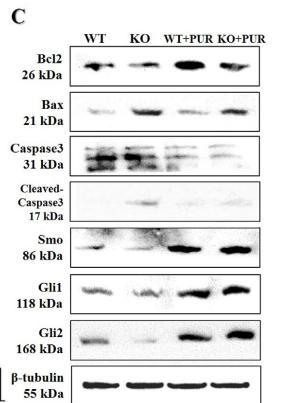SMO Antibody - #DF5152
| Product: | SMO Antibody |
| Catalog: | DF5152 |
| Description: | Rabbit polyclonal antibody to SMO |
| Application: | WB IHC IF/ICC |
| Cited expt.: | WB |
| Reactivity: | Human, Mouse, Rat |
| Prediction: | Pig, Bovine, Horse, Rabbit, Chicken |
| Mol.Wt.: | 86 KD; 86kD(Calculated). |
| Uniprot: | Q99835 |
| RRID: | AB_2837342 |
Related Downloads
Protocols
Product Info
*The optimal dilutions should be determined by the end user. For optimal experimental results, antibody reuse is not recommended.
*Tips:
WB: For western blot detection of denatured protein samples. IHC: For immunohistochemical detection of paraffin sections (IHC-p) or frozen sections (IHC-f) of tissue samples. IF/ICC: For immunofluorescence detection of cell samples. ELISA(peptide): For ELISA detection of antigenic peptide.
Cite Format: Affinity Biosciences Cat# DF5152, RRID:AB_2837342.
Fold/Unfold
Frizzled family member 11; FZD11; Gx; Gx protein; Protein Gx; SMO; SMO_HUMAN; SMOH; Smoothened frizzled family receptor; Smoothened homolog (Drosophila); Smoothened homolog; Smoothened homolog precursor (SMO) (Gx protein); Smoothened seven transmembrane spanning receptor;
Immunogens
A synthesized peptide derived from human SMO, corresponding to a region within N-terminal amino acids.
- Q99835 SMO_HUMAN:
- Protein BLAST With
- NCBI/
- ExPASy/
- Uniprot
MAAARPARGPELPLLGLLLLLLLGDPGRGAASSGNATGPGPRSAGGSARRSAAVTGPPPPLSHCGRAAPCEPLRYNVCLGSVLPYGATSTLLAGDSDSQEEAHGKLVLWSGLRNAPRCWAVIQPLLCAVYMPKCENDRVELPSRTLCQATRGPCAIVERERGWPDFLRCTPDRFPEGCTNEVQNIKFNSSGQCEVPLVRTDNPKSWYEDVEGCGIQCQNPLFTEAEHQDMHSYIAAFGAVTGLCTLFTLATFVADWRNSNRYPAVILFYVNACFFVGSIGWLAQFMDGARREIVCRADGTMRLGEPTSNETLSCVIIFVIVYYALMAGVVWFVVLTYAWHTSFKALGTTYQPLSGKTSYFHLLTWSLPFVLTVAILAVAQVDGDSVSGICFVGYKNYRYRAGFVLAPIGLVLIVGGYFLIRGVMTLFSIKSNHPGLLSEKAASKINETMLRLGIFGFLAFGFVLITFSCHFYDFFNQAEWERSFRDYVLCQANVTIGLPTKQPIPDCEIKNRPSLLVEKINLFAMFGTGIAMSTWVWTKATLLIWRRTWCRLTGQSDDEPKRIKKSKMIAKAFSKRHELLQNPGQELSFSMHTVSHDGPVAGLAFDLNEPSADVSSAWAQHVTKMVARRGAILPQDISVTPVATPVPPEEQANLWLVEAEISPELQKRLGRKKKRRKRKKEVCPLAPPPELHPPAPAPSTIPRLPQLPRQKCLVAAGAWGAGDSCRQGAWTLVSNPFCPEPSPPQDPFLPSAPAPVAWAHGRRQGLGPIHSRTNLMDTELMDADSDF
Predictions
Score>80(red) has high confidence and is suggested to be used for WB detection. *The prediction model is mainly based on the alignment of immunogen sequences, the results are for reference only, not as the basis of quality assurance.
High(score>80) Medium(80>score>50) Low(score<50) No confidence
Research Backgrounds
G protein-coupled receptor that probably associates with the patched protein (PTCH) to transduce the hedgehog's proteins signal. Binding of sonic hedgehog (SHH) to its receptor patched is thought to prevent normal inhibition by patched of smoothened (SMO). Required for the accumulation of KIF7, GLI2 and GLI3 in the cilia. Interacts with DLG5 at the ciliary base to induce the accumulation of KIF7 and GLI2 at the ciliary tip for GLI2 activation (By similarity).
Membrane>Multi-pass membrane protein. Cell projection>Cilium.
Belongs to the G-protein coupled receptor Fz/Smo family.
Research Fields
· Environmental Information Processing > Signal transduction > Hedgehog signaling pathway. (View pathway)
· Human Diseases > Cancers: Overview > Pathways in cancer. (View pathway)
· Human Diseases > Cancers: Overview > Proteoglycans in cancer.
· Human Diseases > Cancers: Specific types > Basal cell carcinoma. (View pathway)
· Organismal Systems > Development > Axon guidance. (View pathway)
References
Application: WB Species: mouse Sample: BGC823MCAs and SGC7901MCAs
Application: WB Species: human Sample: HIBECs
Application: WB Species: Mice Sample: HEI-OC1 cells
Application: WB Species: Mouse Sample: liver cancer cell
Restrictive clause
Affinity Biosciences tests all products strictly. Citations are provided as a resource for additional applications that have not been validated by Affinity Biosciences. Please choose the appropriate format for each application and consult Materials and Methods sections for additional details about the use of any product in these publications.
For Research Use Only.
Not for use in diagnostic or therapeutic procedures. Not for resale. Not for distribution without written consent. Affinity Biosciences will not be held responsible for patent infringement or other violations that may occur with the use of our products. Affinity Biosciences, Affinity Biosciences Logo and all other trademarks are the property of Affinity Biosciences LTD.







